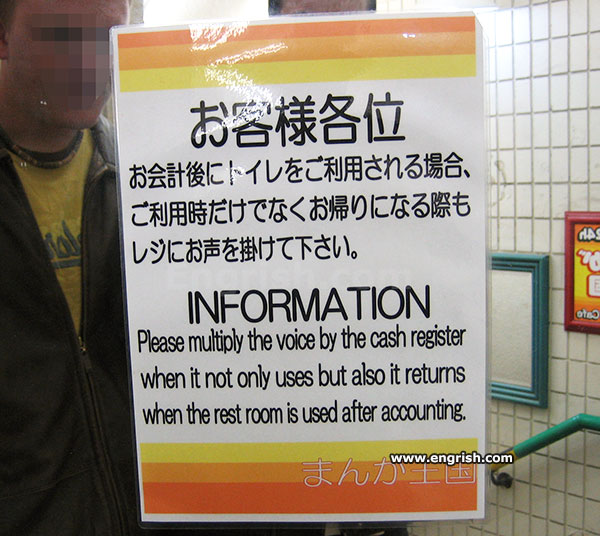Toilet use information mega translation fail
« previous post | next post »
From John Rohsenow, via Mabel Menard, comes this bit of Japanglish:

(source)
Explication de texte par Monsieur Nathan Hopson:
お客様各位
お会計後にトイレをご利用される場合、 ご利用時だけでなくお帰りになる際もレジにお声を掛けて下さい。
Okyakusama kakui
Okaikeigo ni toire o go riyō sareru baai, go riyōji dake denaku okaeri ni naru sai mo reji ni o koe o kakete kudasai.
Valued Customers,
When using the restrooms after purchase, please notify staff both before and after.
More literal version might be:
Customers
In the case that you use the restroom after paying at the checkout counter, please notify [us/staff] both before and after use.
The major problem is with the verb. First, it's wrong in Japanese. Second, it's shitty orthography in Japanese. This sort of thing does not please our new robot masters.
There are two "right" ways to write this:
お声掛けください
お声をおかけください
The sign mixes the two to create a mutant hybrid of slovenly keigo:
お声を掛けて下さい
And don't even get me started on ください vs. 下さい, which is one of those artifacts of front-end processing that is simply ugly and bad and should be summarily shot.
grâce au Nathan
Selected readings
Chris Barts said,
July 25, 2023 @ 11:24 am
The robot masters (Google Translate) had little problem the transcribed text:
Dear Customer,
If you want to use the restroom after paying, please ask the cashier not only when you use it but also when you leave.
Chris Button said,
July 25, 2023 @ 1:29 pm
Et pourquoi est-ce qu'on peut pas utiliser 下さい avec «…て»?
Laura Morland said,
July 25, 2023 @ 3:54 pm
Une petite précision: l'on n'utilise pas l'article défini avec une personne, si elle n'a pas de titre, par ex., "Monsieur le Président" ou bien "le Père Jean Dumont".
C'est donc "grâce à Nathan", pas "au".
PS Is "accounting" to be understood to mean what is translated as "convenience" from the Chinese in yesterday's post?